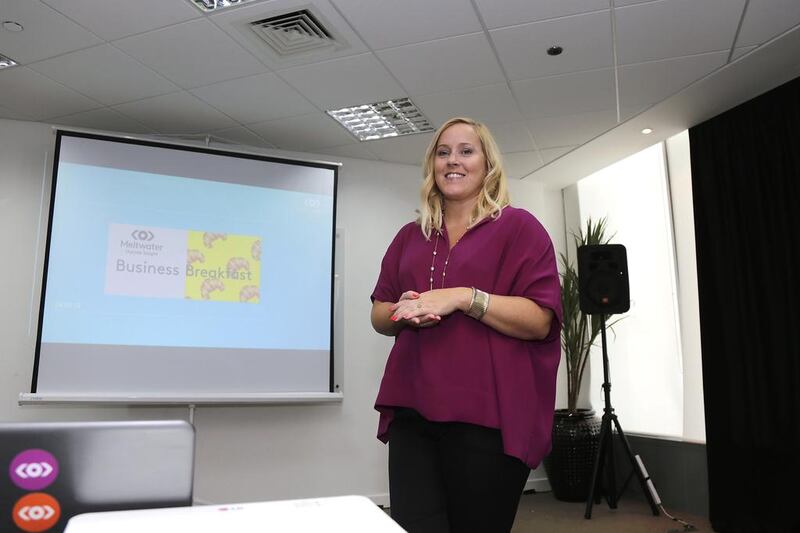As the director of public affairs at New York University Abu Dhabi, Kate Chandler is always keen to spread the word about any groundbreaking research carried out at the Saadiyat Island campus.
And like a growing number of UAE educational institutions, she turns to social media to share news. But not everyone on Facebook wants to read articles about highbrow research, the executive has found.
“What they actually respond to is a picture of a bike on campus, and I’m not making that up”, she tells an audience at a business breakfast organised by Meltwater, a media intelligence company that NYUAD hires to monitor its social media channels.
“We posted a story about sea level change, which got a few likes and shares. Then we posted a picture of a bike, which got 400 likes and was shared 150 times. Our most clicked-on story ever, which got about 1,500 clicks, was pictures of 10 freshman dorms and quotes on why the students decorated them that way.”
Ms Chandler acknowledges it can be tricky for universities to know what resonates on social media. The first step, she says, is to understand the audience, which as well as current students includes prospective students, alumni, parents, community members, faculty and staff.
“Figuring out how to speak to all of these people is one of our biggest challenges, and also one of our biggest opportunities”, says Ms Chandler, adding that compelling images are key.
“You don’t need to write five pages of text because they’re probably not going to read it. But if you put a really good image with a snappy caption, it’s going to get liked and shared.”
While tech-savvy corporations are already aware of the rules of social media marketing, some educational institutions are relatively late to the game.
“NYUAD only really became active on social in 2013,” Ms Chandler says. They have now grown organically to almost 15,000 likes on Facebook, 8,000 Twitter followers and 2,500 likes on Instagram – up 200 per cent on last year.
"For us, Facebook is a celebration channel," says Ms Chandler. "That's where we put students' stories, achievements and things we want people to share, like and hashtag in a positive way. Twitter is more of a news feed, so it might be 'Jane Goodall is on campus'. On Instagram, we do a combination of canvas arty shots – we find people really respond to those. We get an average of 200 likes each."
Melanie Carpenter, the digital director for Seven Media, has conducted social media campaigns for Gems schools and Cranleigh School in Abu Dhabi and says more schools are looking to Instagram. But there are still challenges.
“Instagram requires more ‘student activity on campus’ content, rather than corporate content”, she explains. “But many schools do not allow mobile phones on campus, and the content being shared needs to be controlled. We’ve suggested nominating responsible students as social media ambassadors or content gatherers to get around this.”
Identifying social influencers is important for NYUAD’s social media strategy. “A lot of them intern with us,” says Ms Chandler. “The university hasn’t actively tried to piggyback on a student with a wide social media following, but we have posted stories that a social influencer has shared, and they then blew up.”
With Snapchat hugely popular among young people, Ms Carpenter says it is worthy of schools’ attention – but warns it could open up an even bigger can of worms.
“Because of its very instant nature, controlling the content and the message is much harder,” she says. “It’s important the schools get their Facebook, Twitter and Instagram strategies right first. Just because everyone else is on Snapchat, it doesn’t mean it’s right for you.”
NYUAD is trying to decide how to use the platform “without being too PR, because nobody wants that,” says Ms Chandler, adding that one idea is Snapchat ambassadors, involving students who understand the medium and how to make posts fun.
This is because NYUAD’s most effective campaigns generally involve students.
Earlier this year, her team asked students to submit pictures and captions on Instagram with the hashtag #IknowwhatyoudidlastJanuary, to highlight their J term (a three-week programme where students travel the world).
“We got over 550 submissions in three weeks, curated a bunch of them and put them on our website. It was hugely fun, cost us nothing and was a great way to engage our students,” says Ms Chandler, who also recommends using engaging stories that tug the heartstrings.
She points to a video campaign from Western Sydney University that has garnered three million views on YouTube. It tells the story of the graduate Deng Adut, a Sudanese refugee who taught himself to read at 15 and is now a lawyer.
business@thenational.ae
Follow The National's Business section on Twitter





